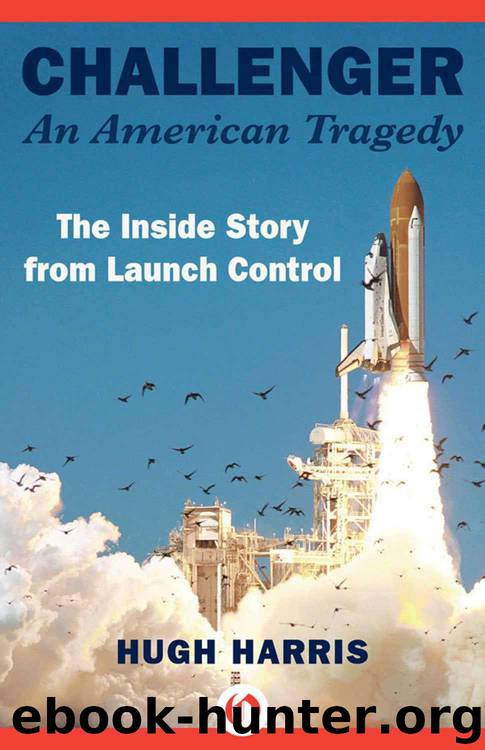Challenger: An American Tragedy: The Inside Story from Launch Control by Hugh Harris

Author:Hugh Harris
Language: eng
Format: azw3
ISBN: 9781480413528
Publisher: Open Road Media
Published: 2014-01-28T05:00:00+00:00
Chapter Nine: Whose Fault Was It?
Soon after the accident, there were rumors of a meeting that took place the night before the launch that should have stopped it but didn’t. Just like the press, the public affairs office hears hundreds of rumors and has to determine whether they’re accurate before reacting in one way or another.
This one turned out to be true.
More than thirty Thiokol engineers, managers, and even vice presidents discussed concerns about the O-rings and cold temperatures with another half dozen or more officials from the Marshall Space Flight Center the day before launch.
These same concerns had been the subject of memos and warnings for years, but somehow were not discussed in the launch readiness reviews for Challenger. The Marshall solid-motor managers had gotten used to seeing hot gases get past the primary O-rings on the field joints and were trusting the secondary O-rings to prevent a breach.
In addition, dozens of engineers and managers who had been involved in examining motors after they flew had seen the blowby of hot gases and soot past the primary O-ring and some erosion of the secondary O-ring.
Yet, despite having all of the right people looking at the concerns, the information never reached final decision makers like Launch Director Gene Thomas and Associate Administrator Jesse Moore.
If I had any doubts about the value of having a presidential commission investigate the Challenger disaster, the hearings put those doubts to rest.
Without the commission, the story would have come out eventually in the course of the investigation. But written reports don’t have the drama of courtroom-style testimony, or make as great an impression on people, whether within the program or in the general public. Nor, I think, would the launch decision process, the design concerns, and the technical details of the hardware have ended up being taught in almost every engineering school in the world had the information been presented differently.
The press played an important role as well. Once the cause of the accident was known, reporters scrambled to see how long the O-ring problem had been known. The New York Times and Washington Post printed articles revealing that even a budget analyst, Richard Cook, had mentioned O-ring concerns, pointing out the impact of an accident on future budgets. They also reprinted memos from Thiokol SRB Engineer Roger Boisjoly, in which he warned management about the danger.
The articles caught Commission Chairman Rogers’s eye. The first day of hearings began with lengthy tutorials on the workings of every element of the space shuttle. Members learned about NASA’s multilayered management system for complex programs like the shuttle and Apollo before it. The Kennedy Space Center and its contractors were responsible for launch processing and launch. The Marshall Space Flight Center in Huntsville, Alabama, and its contractors were responsible for the development and manufacture of the external tank, the engines for the orbiters, and the solid rocket motors. The Johnson Space Center was responsible for the orbiter, astronaut training, and management of the mission once the vehicle cleared the tower.
Download
This site does not store any files on its server. We only index and link to content provided by other sites. Please contact the content providers to delete copyright contents if any and email us, we'll remove relevant links or contents immediately.
Enlightenment Now: The Case for Reason, Science, Humanism, and Progress by Steven Pinker(7234)
A Journey Through Charms and Defence Against the Dark Arts (Harry Potter: A Journey Through…) by Pottermore Publishing(4781)
The Immortal Life of Henrietta Lacks by Rebecca Skloot(4525)
A Journey Through Divination and Astronomy by Publishing Pottermore(4344)
Elon Musk by Ashlee Vance(4029)
Origin Story: A Big History of Everything by David Christian(3648)
COSMOS by Carl Sagan(3554)
Alchemy and Alchemists by C. J. S. Thompson(3450)
Bad Pharma by Ben Goldacre(3356)
Enlightenment Now by Steven Pinker(3338)
Shadow of Night by Deborah Harkness(3302)
Inferior by Angela Saini(3276)
A Mind For Numbers: How to Excel at Math and Science (Even If You Flunked Algebra) by Barbara Oakley(3219)
Origin Story by David Christian(3147)
The Code Book by Simon Singh(3074)
Signature in the Cell: DNA and the Evidence for Intelligent Design by Stephen C. Meyer(3071)
The Elements by Theodore Gray(2998)
A Brief History of Time by Stephen Hawking(2960)
A Journey Through Potions and Herbology (A Journey Through…) by Pottermore Publishing(2828)
